For many of us, rice is a staple food that we prepare frequently. When cooking rice, using a rice cooker can make the process much easier and more convenient. However, you may have noticed that your rice cooker bubbles during the cooking process, leaving you wondering if something is wrong. This article will provide a comprehensive guide to perfecting rice in a rice cooker, covering different types of rice, troubleshooting, cooking time, water measurement, settings, instructions, tips, and best practices.
But first, let’s address the burning question: is rice supposed to bubble in a rice cooker? The short answer is yes. The bubbling sound and activity in your rice cooker are normal and indicate that the water is boiling and the rice is cooking. However, excessive bubbling may indicate an issue with the water-to-rice ratio or the quality of the rice being used.
Now, let’s delve deeper into the nuances of rice cooking in a rice cooker and how to achieve the perfect rice every time.
Key Takeaways:
- Bubbling in a rice cooker is normal.
- Excessive bubbling may indicate an issue with the water-to-rice ratio or the quality of the rice being used.
- This article will provide a comprehensive guide to perfecting rice in a rice cooker, covering different types of rice, troubleshooting, cooking time, water measurement, settings, instructions, tips, and best practices.
Understanding Rice Cooker Bubbling
When using a rice cooker, you may notice a bubbling sound during the cooking process. This is completely normal and indicates that the water is boiling and being absorbed by the rice.
The bubbling sound occurs when the water temperature reaches 212°F (100°C) and begins to boil. As the water is absorbed by the rice, the bubbling sound will gradually decrease until it stops completely.
It is important to note that excessive bubbling may indicate that too much water was added to the rice cooker, resulting in a soupy consistency. On the other hand, if there is no bubbling sound, it may indicate that there is not enough water in the rice cooker, which can cause the rice to be dry and undercooked.
Keep in mind that the bubbling sound is just one indication that the rice is cooking properly. It is equally important to use the correct amount of water, follow cooking time instructions, and select the appropriate setting for the type of rice being cooked.

Troubleshooting Rice Cooker Bubbling
While a certain amount of bubbling is expected during the rice cooking process, excessive bubbling may indicate a problem. Here are some common troubleshooting tips to ensure optimal results with your rice cooker.
| Issue | Solution |
|---|---|
| Rice is boiling over | Reduce the amount of water used, make sure the lid is securely in place, and consider reducing the heat setting if your rice cooker allows it. |
| Rice is undercooked | Check the water measurement and adjust accordingly. You may also need to increase the cooking time or set the rice cooker to a high-heat setting. |
| Rice is overcooked or mushy | Only use the recommended water measurement and cooking time for your specific type of rice. If you have followed the instructions and the rice is still overcooked, try using less water or a different rice-to-water ratio. |
| Rice is sticking to the bottom of the pot | Make sure the pot is clean and free from any residue or debris. Additionally, consider adding a small amount of oil or butter to the pot to prevent sticking. |
If you continue to experience issues with your rice cooker, consult the manufacturer’s instructions or reach out to their customer support for further assistance.
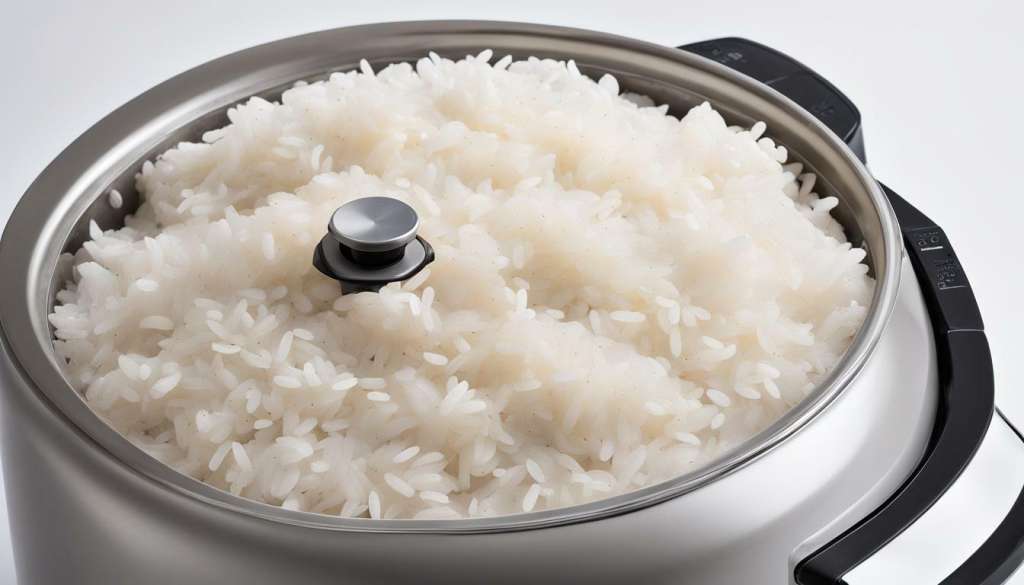
Proper Cooking Time for Different Types of Rice
One of the most critical factors in cooking rice in a rice cooker is determining the proper cooking time. The cooking time varies depending on the type of rice, and it is essential to follow the instructions for each specific variety to achieve the best results.
Here is a general guideline for cooking times for different types of rice:
| Type of Rice | Cooking Time |
|---|---|
| White Rice | 15-20 minutes |
| Brown Rice | 30-40 minutes |
| Wild Rice | 60-75 minutes |
| Sushi Rice | 20-25 minutes |
It is important to note that cooking times may vary depending on the rice cooker model, elevation, and humidity levels, so it is always best to check the manufacturer’s instructions. Additionally, some rice cookers have different settings for various types of rice, which can help achieve optimal results.
Remember to adjust your cooking time according to your rice cooker’s instructions and specifications!
Next, we will show you the importance of measuring water accurately for your rice cooker to achieve perfectly cooked rice.
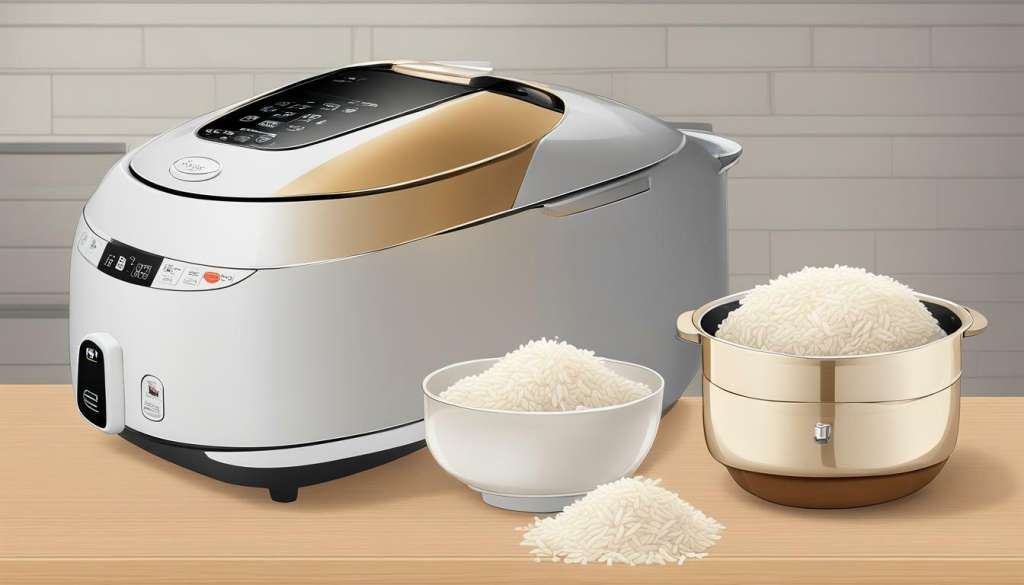
Importance of Water Measurement in Rice Cookers
Accurate water measurement is crucial when cooking rice in a rice cooker. Using too much or too little water can result in undercooked or overcooked rice, affecting its texture and taste. The amount of water needed varies depending on the type of rice being cooked, so it’s essential to follow instructions carefully.
Tip: A general rule of thumb is to use a 1:1.5 water-to-rice ratio for white rice and a 1:2 water-to-rice ratio for brown rice. However, it’s best to refer to the packaging or the rice cooker manual for specific measurements.
The water level indicators on the rice cooker’s inner pot are there to guide you, but they may not always be accurate. It’s recommended to use a measuring cup for precise water measurement. Pour the rice into the inner pot and level it off, then pour the water into the pot, ensuring it reaches the correct water level indicated for the amount of rice being used.
Tip: Some rice cookers may require slightly more or less water depending on the desired texture of the rice. Experiment with water measurement and rice-to-water ratios to find what works best for your rice cooker and your taste preferences.
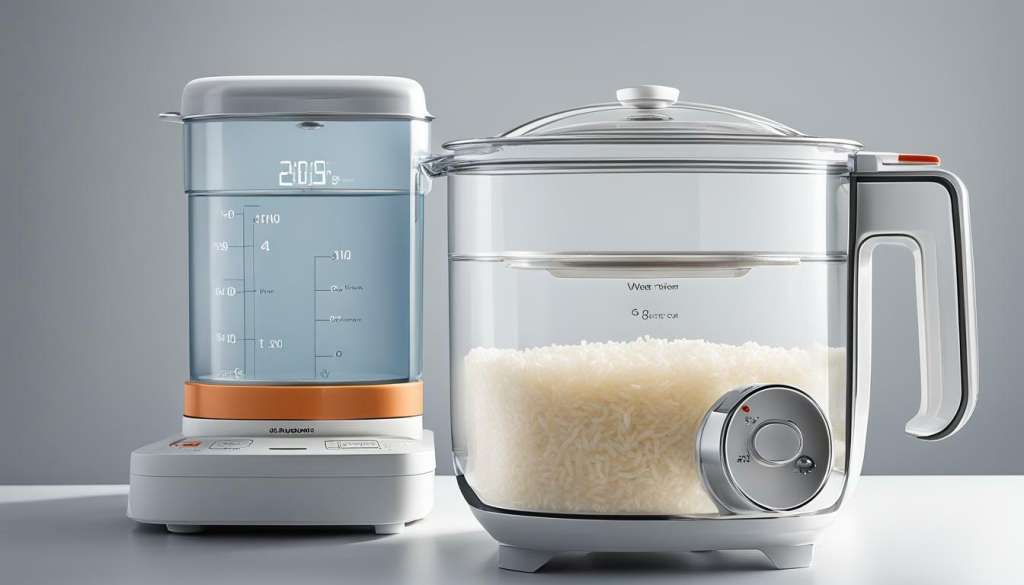
Understanding Rice Cooker Settings
Modern rice cookers come with a variety of settings that allow you to tailor the cooking process to the type of rice you are using. Understanding how to use these settings will help you achieve perfectly cooked rice every time.
Most rice cookers have two basic settings: cook and warm. The cook setting is used to cook the rice, and the warm setting keeps the rice warm without overcooking it. Some rice cookers have additional settings for specific types of rice, such as brown or sushi rice.
When using a rice cooker, it’s essential to choose the appropriate setting for the type of rice you are cooking. For example, if you are cooking brown rice, you will need to use the brown rice setting, which will cook the rice at a higher temperature and for a longer time than white rice. Similarly, if you are cooking sushi rice, you will need to use the sushi rice setting, which will cook the rice at a lower temperature for a longer time.
It’s also important to note that some rice cookers have different settings for the amount of rice being cooked. If you are only cooking a small amount of rice, you may need to use a different setting than if you were cooking a larger amount.
Refer to the manufacturer’s instructions for your specific rice cooker to determine which settings to use for different types and amounts of rice. Remember to adjust the amount of water and cooking time based on the specific instructions for each type of rice as well.
| Setting | Description |
|---|---|
| White Rice | Used for cooking white rice |
| Brown Rice | Used for cooking brown rice |
| Sushi Rice | Used for cooking sushi rice |
| Mixed Rice | Used for cooking mixed rice |
| Porridge | Used for cooking porridge or congee |
| Steam | Used for steaming vegetables, fish, or meat |
Experiment with different settings and rice types to determine the best combination for your rice cooker. With a little practice, you’ll be able to use your rice cooker to cook a variety of rice perfectly every time.
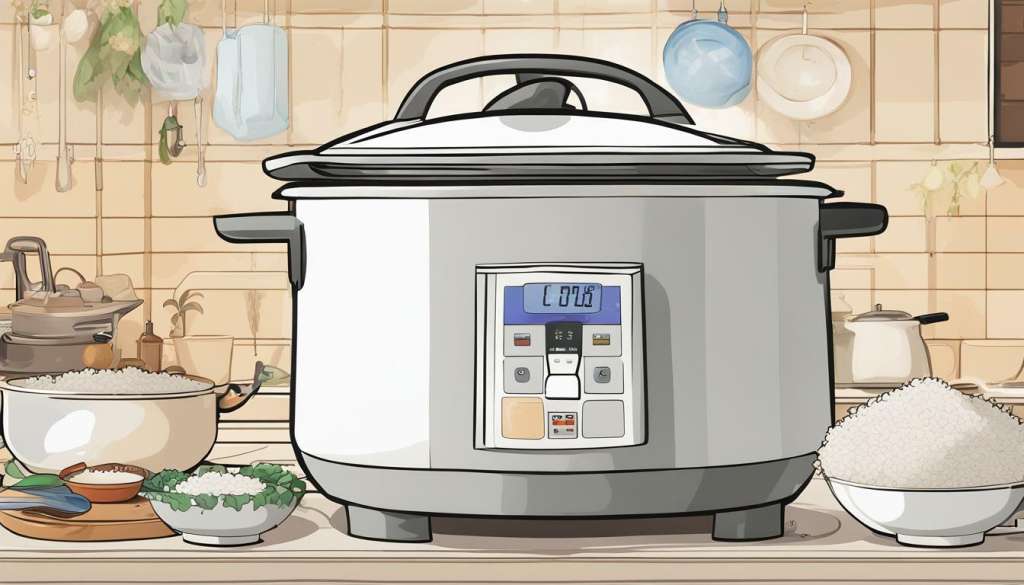
Following Rice Cooker Instructions
When using a rice cooker, it is crucial to follow the manufacturer’s instructions carefully. Each rice cooker is designed differently, and using it incorrectly can result in poorly cooked rice or damage to the appliance.
Begin by measuring the correct amount of rice and water according to the instructions provided with your rice cooker. Most rice cookers come with a measuring cup included, and it is essential to use this cup for accurate measurements.
Next, add the rice and water to the rice cooker’s inner pot, ensuring that the pot is properly seated in the cooker. Close the lid tightly and plug in the cooker. Select the appropriate cooking setting, and allow the rice to cook as directed.
Once the cooking cycle is complete, allow the rice to sit for a few minutes before opening the lid. Fluff the rice gently with a fork to separate the grains and release excess steam.
Remember to always unplug and allow the rice cooker to cool before cleaning. Refer to the instructions manual for proper cleaning and maintenance guidelines to keep your rice cooker in optimal condition.
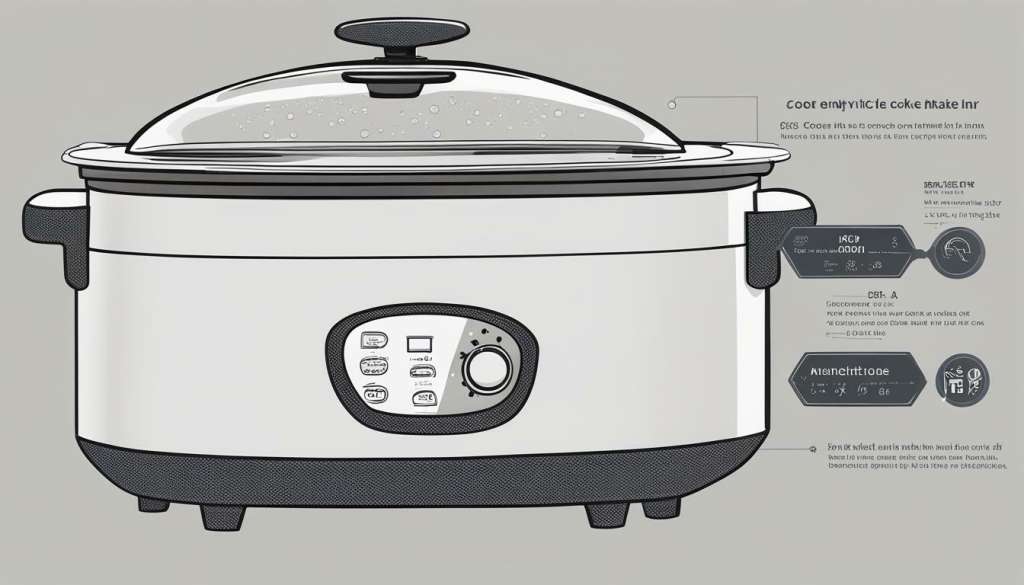
Useful Tips for Cooking Rice in a Rice Cooker
Using a rice cooker can be a convenient way to cook perfect rice every time, but there are certain tips and tricks that can take your rice-cooking game to the next level. Here are some useful tips to get the most out of your rice cooker:
- Wash your rice before cooking: It’s important to rinse your rice before cooking to remove excess starch and debris. Wash your rice with cold water until the water runs clear.
- Soak your rice: Soaking your rice for 20-30 minutes before cooking can help improve its texture and flavor. This is especially true for long-grain rice such as basmati or jasmine.
- Add some flavor: If you want to add some extra flavor to your rice, try adding some broth, herbs, or spices to the cooking water.
- Don’t peek: Once you’ve started the cooking process, avoid opening the lid or stirring the rice. This can disrupt the cooking process and affect the final result.
- Keep it warm: Most rice cookers have a “keep warm” setting that will keep your rice at a consistent temperature after it’s finished cooking. This is useful if you’re not ready to serve your rice right away.
By following these tips, you can make sure your rice is perfectly cooked and full of flavor every time.
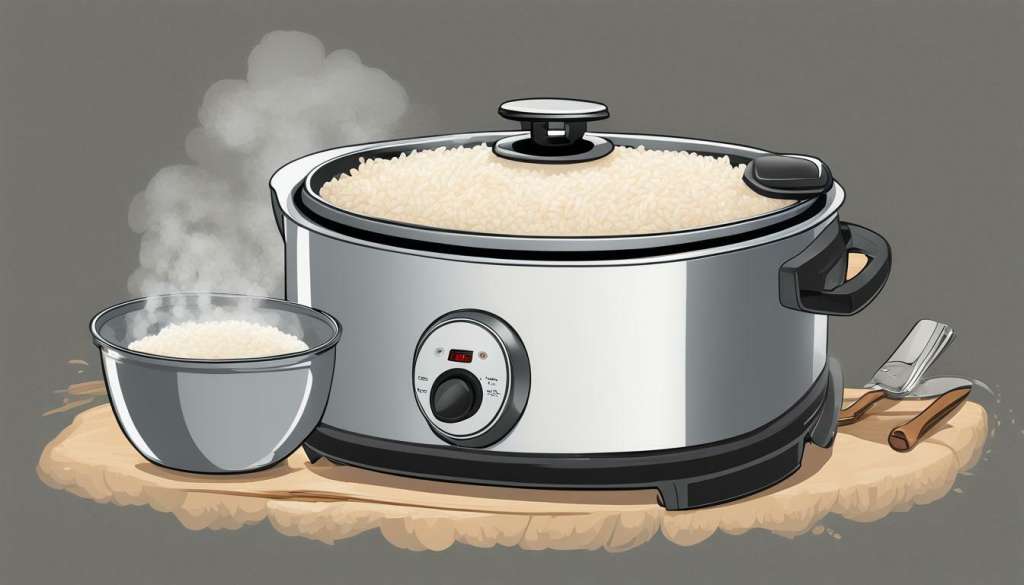
Rice Cooker Best Practices
Using a rice cooker can save you time and effort in the kitchen, but it’s important to follow best practices to ensure optimal performance and longevity of your appliance. Here are some tips to keep in mind:
| Best Practice | Explanation |
|---|---|
| Measure water accurately | Use the provided measuring cup or a standard measuring cup to ensure the correct water-to-rice ratio. Too much or too little water can affect the texture and flavor of your rice. |
| Choose the right rice type | Some rice types, such as brown rice, require longer cooking times than others. Make sure you’re selecting the appropriate setting for your rice cooker and following recommended cooking times. |
| Clean your rice cooker regularly | Follow the manufacturer’s instructions for cleaning your rice cooker after each use. This will prevent buildup and ensure that your appliance continues to function properly. |
| Store your rice cooker properly | After cleaning, store your rice cooker in a dry, cool place. Avoid stacking other appliances on top of it, which can damage the lid or control panel. |
By following these best practices, you’ll be on your way to perfect rice every time. Keep experimenting with different types of rice, water ratios, and seasonings to find your perfect combination. Happy cooking!
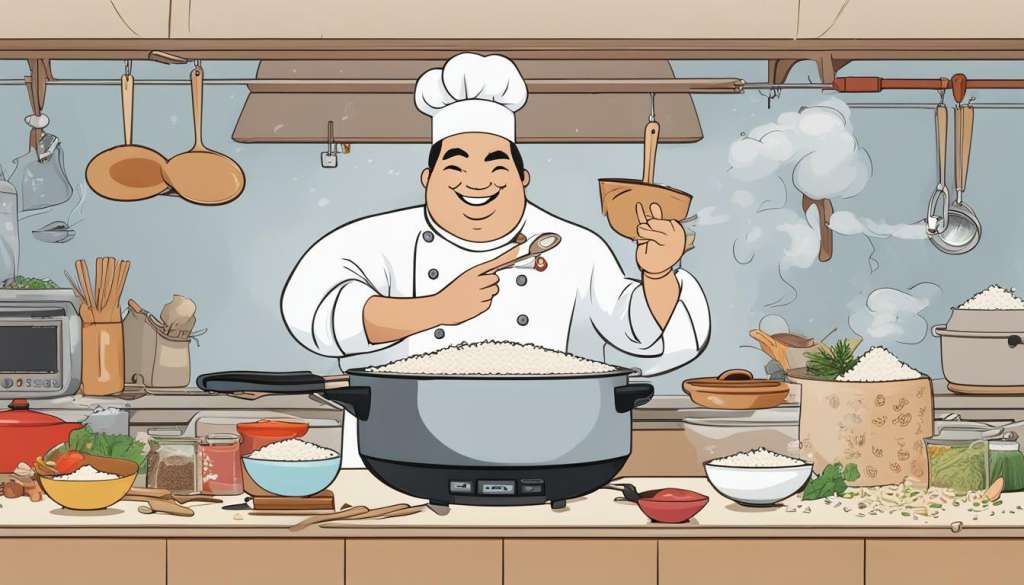
Cooking Jasmine Rice in a Rice Cooker
If you’re a fan of fragrant jasmine rice, you’ll be pleased to know that it’s easy to cook in a rice cooker. Follow these simple steps to get perfect jasmine rice every time:
- Measure the desired amount of jasmine rice and rinse it thoroughly in a sieve under cold running water until the water runs clear.
- Transfer the rinsed rice to the rice cooker pot.
- Add water to the pot according to the manufacturer’s instructions or use the standard ratio of 1 ½ cups of water for every cup of jasmine rice.
- Close the lid and set the rice cooker to the “white rice” or “regular” setting.
- Allow the rice to cook until the cooker automatically switches to the “keep warm” function.
- Let the rice rest for 10-15 minutes before fluffing it with a fork and serving.
It’s important to note that the cooking time for jasmine rice may differ slightly from other types of rice due to its slightly sticky texture and unique flavor profile. If you’re unsure of the cooking time, refer to the package instructions or adjust the cooking time slightly until you find the perfect sweet spot.
For added flavor, consider using chicken or vegetable broth instead of water and adding in a few slices of fresh ginger or a sprinkle of salt.
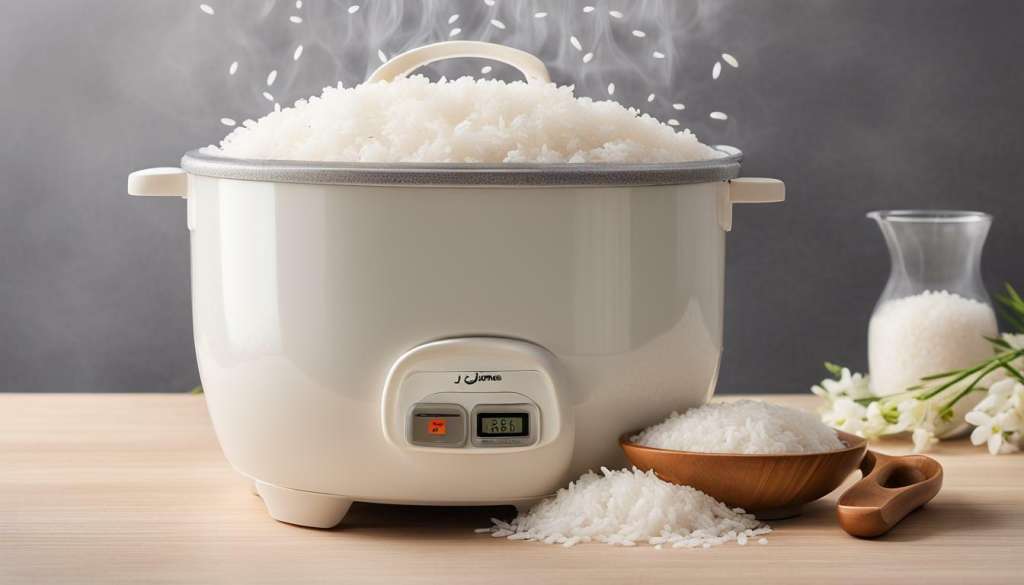
With these tips and tricks, you’ll be able to cook delicious jasmine rice in your rice cooker with ease.
Cooking Basmati Rice in a Rice Cooker
Basmati rice is a long-grain, aromatic rice that originates from the Indian subcontinent. Cooking basmati rice in a rice cooker is a simple and efficient way to achieve perfectly fluffy and fragrant rice.
Step 1: Rinse the basmati rice thoroughly in cold water until the water runs clear. Drain the rice and let it sit for approximately 15 minutes.
Step 2: Add the rinsed rice to the rice cooker and add water at a 1:1.5 ratio of rice to water. For example, if you are cooking 1 cup of rice, add 1.5 cups of water.
Step 3: Close the lid of the rice cooker and select the “white rice” setting, or use the manual setting and set the timer for 15-20 minutes.
Step 4: Once the rice cooker has finished cooking, let the rice rest for approximately 5 minutes before opening the lid. Fluff the rice with a fork before serving.
Note: Basmati rice can be customized to your liking by adding spices, herbs, or broth to the cooking water for added flavor.
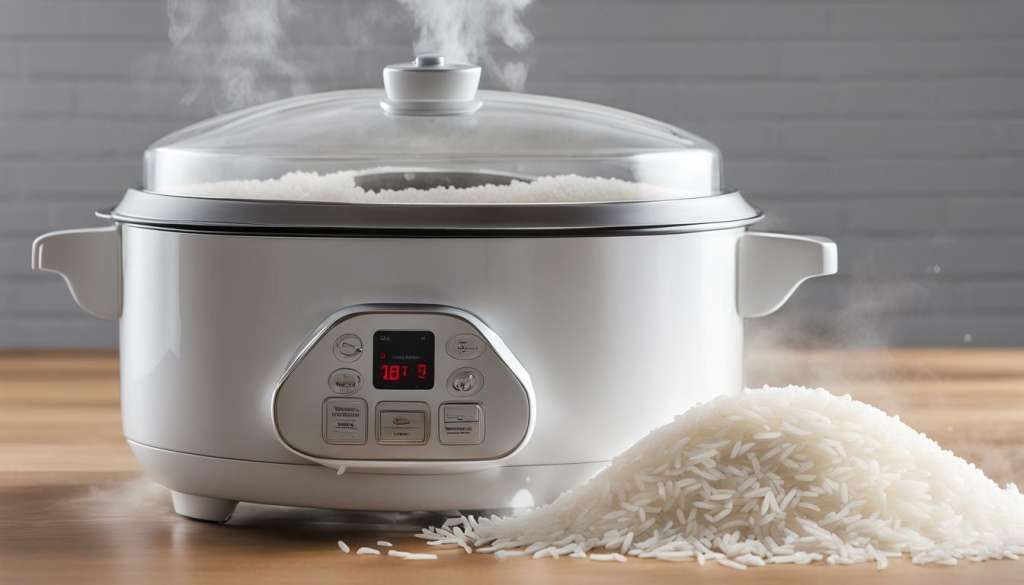
Conclusion
In conclusion, perfecting rice in a rice cooker requires understanding the bubbling sound, troubleshooting potential issues, and following instructions. By using the appropriate settings, water measurement, and cooking time, you can achieve fluffy and flavorful rice every time.
Remember to clean and maintain your rice cooker regularly, and store it properly when not in use. Additionally, by implementing our useful tips and best practices, you can elevate your rice-cooking experience and impress your guests with delicious rice dishes.
Whether you’re cooking fragrant jasmine rice or aromatic basmati rice, our comprehensive guide has got you covered. With the right approach and attention to detail, you can use your rice cooker to its full potential and enjoy perfectly cooked rice with every meal.
FAQ
Q: Is rice supposed to bubble in a rice cooker?
A: Yes, it is normal for rice to bubble in a rice cooker during the cooking process. The bubbling is caused by the release of steam and indicates that the rice is cooking properly.
Q: What causes the bubbling sound in a rice cooker?
A: The bubbling sound in a rice cooker is caused by the steam and water inside the cooker boiling. It is a sign that the rice is cooking and the water is evaporating.
Q: How can I troubleshoot excessive bubbling in my rice cooker?
A: If you are experiencing excessive bubbling in your rice cooker, try adjusting the water-to-rice ratio. Too much water can cause excessive bubbling. Additionally, make sure the rice cooker is properly sealed and functioning correctly.
Q: What is the proper cooking time for different types of rice in a rice cooker?
A: The cooking time for different types of rice can vary. As a general guideline, white rice typically takes around 15-20 minutes to cook, while brown rice may take 30-40 minutes. Refer to the instructions provided with your rice cooker for specific cooking times.
Q: How important is water measurement in a rice cooker?
A: Accurate water measurement is crucial for achieving perfectly cooked rice in a rice cooker. Follow the recommended water-to-rice ratio provided in your rice cooker’s instructions to ensure the best results.
Q: What are the different settings on a rice cooker for?
A: Rice cookers often have different settings such as white rice, brown rice, steam, and warm. These settings allow you to customize the cooking process based on the type of rice you are using and your desired outcome.
Q: How do I properly use a rice cooker?
A: To use a rice cooker, first rinse the rice thoroughly and add it to the inner pot. Add the correct amount of water according to the instructions. Close the lid, select the desired cooking setting, and let the rice cooker do its job. Once the rice is cooked, allow it to rest for a few minutes before fluffing it with a fork.
Q: What are some tips for cooking rice in a rice cooker?
A: Here are some useful tips for cooking rice in a rice cooker:
1. Rinse the rice before cooking to remove excess starch.
2. Use the correct water-to-rice ratio.
3. Let the rice rest for a few minutes after cooking to allow it to fully absorb the moisture.
4. Avoid lifting the lid while the rice is cooking to prevent heat and steam loss.
Q: What are the best practices for using a rice cooker?
A: To ensure optimal performance and longevity of your rice cooker, follow these best practices:
1. Clean the rice cooker regularly according to the manufacturer’s instructions.
2. Avoid using metal utensils that may scratch the inner pot.
3. Store the rice cooker in a cool and dry place when not in use.
4. Use the proper measuring tools to ensure accurate water and rice measurement.
Q: How do I cook jasmine rice in a rice cooker?
A: To cook jasmine rice in a rice cooker, rinse the rice thoroughly, and add it to the inner pot. Add the recommended amount of water according to the instructions, usually a bit less than the 1:1 ratio for white rice. Select the white rice setting on your rice cooker and let it cook. Once done, let it rest for a few minutes before fluffing and serving.
Q: How do I cook basmati rice in a rice cooker?
A: To cook basmati rice in a rice cooker, rinse the rice well and add it to the inner pot. Add water according to the recommended water-to-rice ratio, usually around 1.5 cups of water for every 1 cup of rice. Select the white rice setting on your rice cooker and let it cook. Allow the rice to rest for a few minutes before fluffing and serving.


